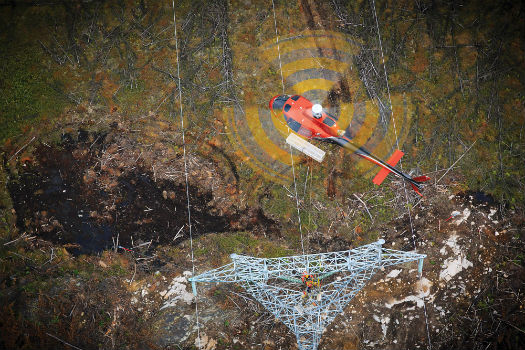
The I1K transmission line in Northern Saskatchewan is one of several major power line construction projects either currently underway or recently completed in Canada. During the peak of activity on the line, up to 15 helicopters were working on it.
For those working in the utility sector in Canada, the last couple of years have not been particularly kind. Mineral exploration has slowed to almost a standstill; tanking oil prices have stunted development offshore and in the robust oil sands market in northern Alberta; and while extensive firefighting operations provided much-needed work in Western Canada this summer, the opposite was true on the East Coast.
But even though the current situation has proved to be something of a perfect storm, there are still sectors that have provided a relatively stable source of work for some utility operators over the past few years. One of the most notable among these is power line construction, fueled both by the need to bring reliable power supply to the growing populations of remote settlements, and the need to replace aging transmission lines that are reaching the end of their natural life.
Within this sector, there have been several major projects that have been so large in scope that they have required the services of entire fleets of aircraft — and made headlines in mainstream media. Among these are the Northwest Transmission Line and Interior To Lower Mainland project in British Columbia, the upcoming Muskrat Falls project in Newfoundland and Labrador, and the ongoing I1K power line project in Northern Saskatchewan — to which the only access is by air. Vertical spoke to those who have worked on these major projects to find out what life is like on the line.

Northern Saskatchewan may be largely flat, but with myriad lakes and swamps restricting access, construction of the I1K transmission line was only possible by air. HTSC Photo
A ‘One-of-a-Kind’ Project
Of all the herculean power line construction projects recently undertaken in Canada, the I1K power line project in Northern Saskatchewan may be one that demands industry attention more than any other; everything required to create the 300-kilometer (185-mile) stretch of power line — from the initial survey to the stringing of the line — has had to be either be flown in or completed by air.
The three-year C$200-million project, scheduled be completed at the end of October, saw the construction of the line along the right-of-way of an existing power line that travelled northwest from the Island Falls hydroelectric power station to the Key Lake uranium mine. There were only three access points for the project: at the terminus points of Island Falls and Key Lake, and at Lindsay Lake, roughly halfway between the two.
The task of completing this challenging project fell to experienced contractor Valard Construction, which won the contract for the work from utility provider SaskPower. Valard also managed the NTL project in B.C., and is the main contractor on the Muskrat Falls project on the East Coast.

VIH Helicopters had a Kamov Ka-32A11BC working on the I1K transmission line for almost two full years. A second Ka-32 joined it during peak construction times.
“There haven’t been any projects of this scale for probably 20 or 30 years in this country,” Bill Ross, Valard Construction’s helicopter operations manager, told Vertical. “It just happens to be a period of intense infrastructure growth right now.”
Ross said the I1K was one of the most spectacular of a range of projects Valard was working on.
“You can’t drive down the right of way at all,” he said. “Everybody that works on the line doing anything needs a helicopter ride to get out there. All the foundation work is done by helicopter, all the tower setting, all the wire stringing… Everything is supported by this mixture of birds that we have here. It’s a one-of-a-kind project in the country.”
In addition to Valard’s own fleet of two Airbus Helicopters AS350 B3 AStars and an Eagle Single (a Bell 212 converted to a single-engine aircraft by Eagle Copters), the company has used a Sikorsky CH-54B, two Kamov Ka-32A11BCs, Bell 212s, Bell 205s, Bell 407s, and AS350 AStars from outside operators on the project.
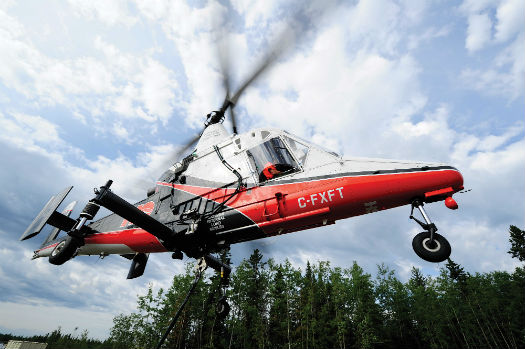
Heliqwest’s Bob Chalifoux said the Kaman K-MAX was a popular aircraft among ground crews due to its quiet operation and the lack of downwash for those working underneath. Mike Reyno Photo
“At the height of things, we had about 15 aircraft here,” said Ross. “A lot of what we do is special operations type work, where you’re doing structure access, hover exiting, and light skid landings on the bridges of the towers, which isn’t for every pilot.”
Because of that, Valard has built up a trusted pool of operators to use on its projects, but it also tries to hire local companies as often as possible. Among those working on the I1K project were Airspan Helicopters, Helicopter Transport Services, Arrowhead Helicopters, Helifor, VIH Helicopters, Vortex Helicopters, and Transwest Air.
Justin LeBlanc, assistant project manager with Valard Construction on the I1K transmission line, said that a typical day on the project began with a morning meeting — known as a tailboard — during which the team would create an action plan for the day’s work. Aircraft maintenance would generally be completed overnight to ensure a full productive day, and the helicopters would be divided into long lining or crew transport roles, saving the time it would take to change the configuration of an aircraft from one to the other.
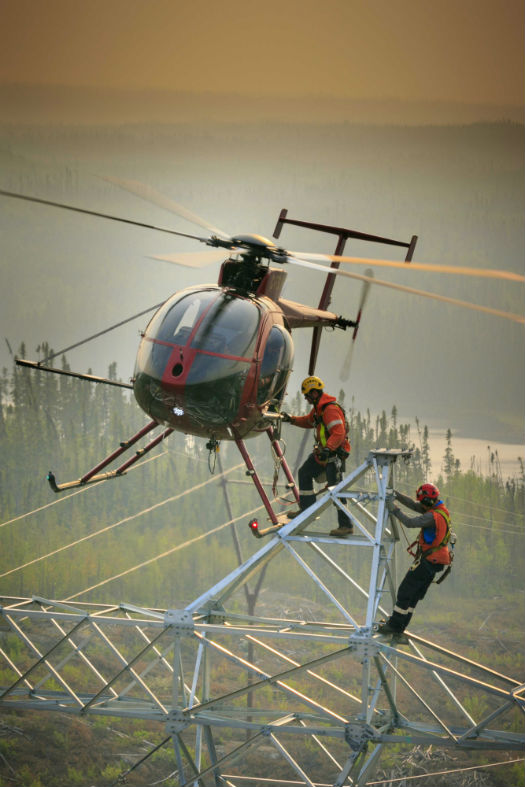
An MD 500E from Vortex Helicorp on the I1K near Island Falls, Sask. Duties for the 500E varied, but mainly consisted of power line “threading” (pulling the cable through a traveller pulley on the towers) and crew movements.
“The first thing was to get all the crews out to the line so they could prep their sites,” said LeBlanc. “That was anywhere from 15 minutes to one hour one way, depending on where we were on the line. After that, the helicopter crews were typically assigned a set of priorities to get done first thing in the morning — certain loads that were developed the previous day they never got to — drop those off and bump crews site to site. Then it was generally working on a on-call basis throughout the day, depending on the crew’s workflows.”
In addition to dealing with poor weather during the fall and winter in Northern Saskatchewan, Ross said the main challenge for those working on the job was the high intensity of the traffic.
“There were up to a dozen aircraft on the project at any one time, and some of them were working in pretty close proximity to each other,” said Ross. “So it was very busy on the air with the different radios; the guys were in constant contact with the line crew on the ground, and, while we were in uncontrolled airspace, you still needed to let the local traffic know what’s going on.”
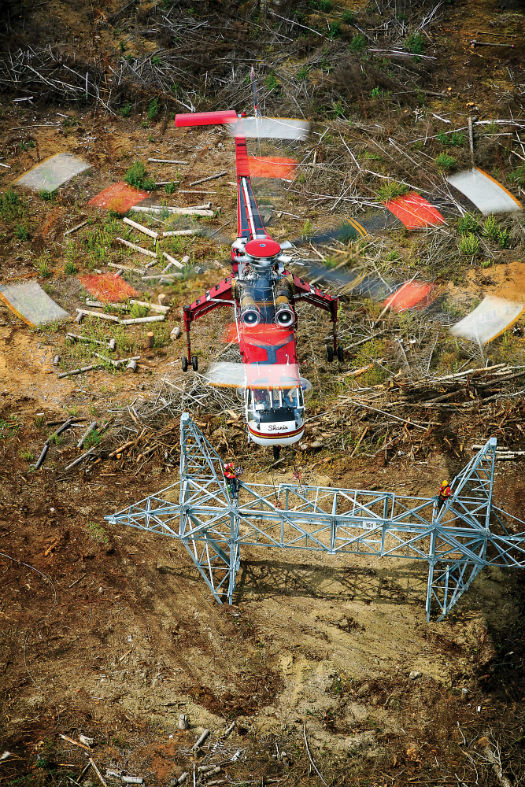
Valard chose Helicopter Transport Services’ Sikorsky CH-54B — rather than an Erickson S-64 E or F model — for its enormous 25,000-pound lift capacity.
Sherey Byra, a helicopter coordinator/dispatcher for Valard on the I1K project, said the best tool the company had was the TracPlus system, which was compatible with a wide variety of flight tracking systems, allowing her to see every aircraft from every operator on the project at any given time.
She said the biggest challenge of her role was getting all the aircraft out in a timely and efficient manner each morning — and then working through the various requests from crews out in the field. “You have to know how to prioritize, and that basically just comes from management — because what type of crew is a priority today may not be the same type tomorrow,” she said.
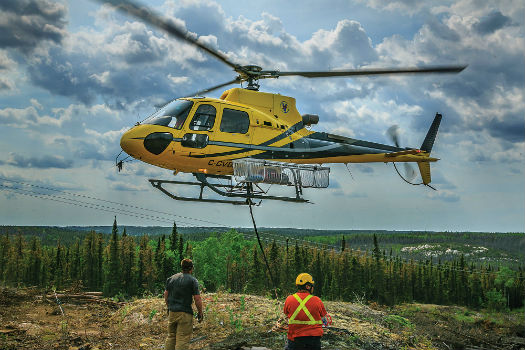
There has been something of a boom in major power line construction projects across Canada, with two in B.C., one in Saskatchewan, and another recently beginning in Labrador.
Getting Heavy
The I1K project proved to be almost tailor-made for the Kamov Ka-32A11BCs of VIH Helicopters, which was used to move the foundation crews’ loaders and equipment, as well as slinging the towers themselves.
“Everybody knows that the Kamov is a workhorse, and it just happened to fit the niche here for the weights of the stuff that we have,” said Ross. “Not everything is over 10,000 pounds, but we do have structures that are over 10,000 pounds that they can handle. Any piece of equipment can be taken apart and moved by smaller helicopters, but the reassembly time is a big factor in the productivity of the crew. Sometimes you have to move the drills daily, and if it takes two days to take it apart, and two days to put it back together — five days instead of one — it’s not much of a choice to make.”
VIH had one of its Ka-32s working on the project for almost two full years, and it was joined by a second for several months during peak times. The operator has focused in on the heavy-lift market in recent years, with an “intentional restructuring” of its fleet distilling it to just five aircraft — four Ka-32s and a Sikorsky S-61.
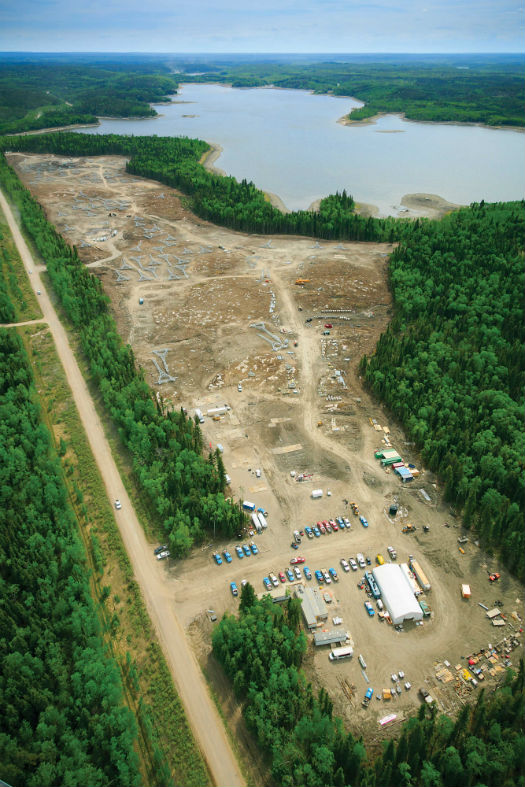
The I1K line spans 300 kilometers — and every tower on it had to be placed by helicopter.
“There’s lots of work out there,” said Brian Mycroft, director of operations at VIH. “It’s competitive to get it, but we employ really good precision pilots, and the Kamov is easy to maintain for us — we know it well. We also know a good deal about power lines, we like the work, and it’s something that we’re really good at.”
Mycroft said the weight of the towers on the I1K project — about 10,800 pounds or 4,900 kilograms — was a perfect fit for the Ka-32’s lift capacity.

Helifor has found plenty of work in Canadian power line construction projects in recent years. In its work on the Interior to Lower Mainland project in British Columbia, it flew 2,300 hours between its Vertol 107 and MD 500. Dan Sweet Photo
“When a customer is getting a heavy helicopter, they don’t want to pay for much reserve,” he said. “If you have 11,000-pound weights, you get a machine that’ll lift 11,000 pounds. We fill a pretty unique weight class because the S-61 and the Vertol [107] are all down around the 9,000/10,000-pound range, and a Kamov will easily lift 11,000. It’s sort of one step in between there and a [S-64] crane.”
Tom Schneider, a VIH pilot who flew the Ka-32 on the I1K project, said the aircraft’s lift performance and precision capabilities made it well suited to the work.
“It handles its maximum load really well and it also has pretty good altitude performance,” he said. “It’s certainly impressive in hot days and higher altitudes.”

The size of the towers on the I1K transmission line — weighing about 10,800 pounds — were well suited to the Ka-32’s 11,000-pound lift capability.
Joining VIH in doing the heavy lifting on the project was Helicopter Transport Services (HTS), which is based near to the line in La Ronge, Sask. The operator used its Sikorsky CH-54B on the project (at one point using two of the heavy lift juggernauts, which can lift up to 25,000 pounds/11,340 kilograms on the hook), but also had a unique agreement with Valard that took advantage of HTS’ diverse range of aircraft.
“They’re close, and we had an arrangement with them so that we could get their machines in and out as required,” said Ross. “They knew they were going to be here for the entire season, but the exact machines varied from month to month — it could be two or three mediums, or two or three intermediates. The ability to mix and match really helped us.”
Ross said Valard chose the CH-54B because of its lifting capacity. “As a restricted category aircraft, it’s lighter than the [Erickson S-64] E or F models,” he said. “In this particular project, we have some structure components that are just too heavy for the F model crane, and just doable by this [CH-54 B] version that HTS has.”
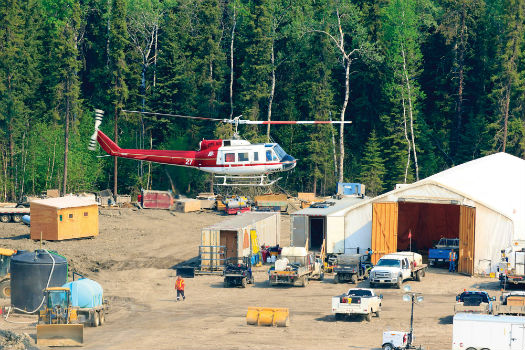
Through a unique agreement with contractor Valard, a range of aircraft from Helicopter Transport Services were utilized on the construction project in Saskatchewan.
Mike Lavoy, vice president of marketing and communications at HTS, said the I1K project was the biggest job the company had completed in the last year.
“We did almost everything through the different phases of construction except the wire pulling for the main power cables,” he said. “It’s a bit of a complex job when you do it with helicopters, because it gets really busy around the line itself. You’ve got to see, be seen, and work to a certain procedure. It’s the same idea as a highway, you fly on the right hand side, stay out of the way of the machines that are pulling, and communicate. Know who’s talking, what they’re talking about and where they are.”
In terms of other power line construction prospects, Lavoy said that while the degree of helicopter involvement is often only determined while a project is underway, there was a fairly consistent amount of work out there. “There’s always upgrades or new lines because of new generation, and it’s a pretty even flow,” he said. “It’s not the big swings that you get in something like forest fires or the mining exploration sectors.”
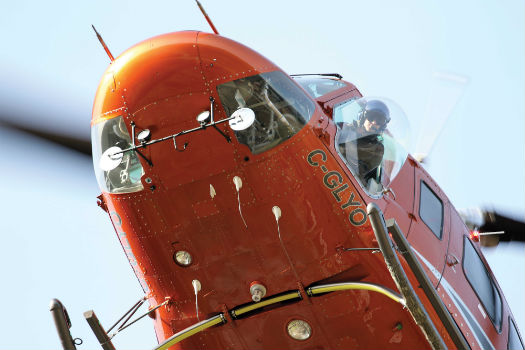
Airspan’s Bell 212 was largely used to support foundation crews on the I1K project. Jeff Wilson Photo
Justin Gloag, a pilot at Airspan Helicopters who worked on the I1K project, was also positive about the amount of power line construction opportunities available. “Airspan Helicopters, for the last two years maybe, has kind of specialized in it,” he said. “We do a lot of the stringing work on the AStars — we hang the glass and we help the crews tie in the line after it’s been strung. And that’s definitely challenging work.”
Gloag said on the I1K project, Airspan’s Bell 212s were largely used to support the foundation crews. “It can lift around the 3,000 to 4,000 pound mark — and with that, you’ve got the ability to transport up to nine or 10 people,” he said. “It’s a good machine for that bracket.”
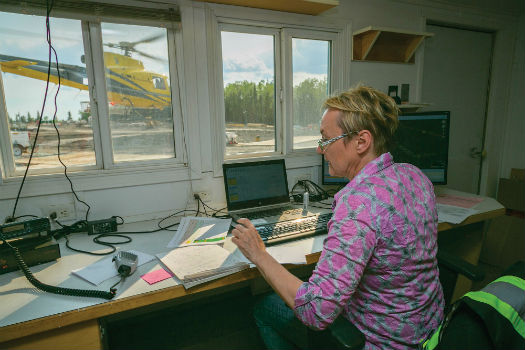
Helicopter dispatcher Sherey Byra said the main challenge on the I1K project was getting all the crews out in a timely manner in the mornings.
B.C. Power Boost
On Canada’s West Coast, the two major power line projects — the Northwest Transmission Line (NTL) and Interior To Lower Mainland (ILM) project — have been among the largest construction projects in the province of British Columbia for several decades. And both made extensive use of helicopters.
The $746-million NTL spans 344 kilometers (214 miles) between the city of Terrace and a new substation near Bob Quinn Lake in B.C. The 287-kilovolt line was powered on in summer 2014 and contains close to 1,100 transmission structures and 2,100 kilometers (1,300 miles) of transmission cable.

Maintenance technicians take a look at the coaxial Ka-32 after a day of flying. Two mechanics travel with the aircraft to look after it in the field.
In the south of the province, the $725-million ILM was scheduled to be completed this year. The 247-kilometer (153-mile) 500-kilovolt transmission line runs between Merritt and Coquitlam, and has been created parallel to an existing line. Once finished, it will carry enough electricity to power 80,000 homes.
Helifor, based in Campbell River, B.C., was involved in both projects — as well as the I1K in Saskatchwan — and Chris Carswell, project manager of lift services at Helifor, said the company was seeing an uptick in power line construction work.
“It is increasing — there are definitely projects coming online with the aging infrastructure and more demand for power,” he said.
The ILM was the largest contract for Helifor, where it was tasked with falling and clearing the right of way, and then working on the tower foundations. Between its Vertol 107 and MD 500, it flew 2,300 hours on the project.

The CH-54B Skycrane generally travels with a crew of seven, which includes four mechanics and three pilots.
Carswell said Helifor’s pilots brought vast experience to the project. “Our pilots have been with the company an average of 15 to 17 years,” he said. “For many of them, that’s all they ever really done with Helifor — fly a long line with a Vertol [107]. And because we do a lot of heli-logging, we’re used to getting into tight areas with our 500s and different logging blocks. So that helped when they were working around power lines.”
All the pilots also attended a BC Hydro flying the wire course — part of a stringent safety system the utility provider has in place. “They have a whole auditing program, and so they came over, audited us for a few days, and looked at all of our systems,” said Carswell. “So, we’re approved to work on any B.C. Hydro project.”
Blackcomb Aviation is another company that worked on both B.C. projects, typically using its three Airbus Helicopters AS355 N TwinStars to transport crew and materials, and pull sock line (a thin wire or rope used to thread the transmission line through tower pulleys). It also has a longstanding power line maintenance support contract with BC Hydro, and has been taking part in a spacer damper change program that requires long lining linemen onto energized wire with an Airbus Helicopters EC135 T2+ — making it one of a handful of companies in North America to perform this operation.
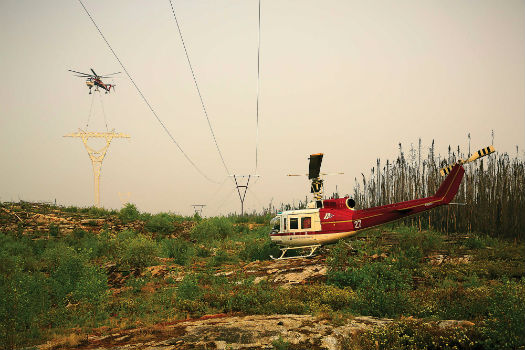
A Bell 205 from Helicopter Transport Services looks on from beside an old power line, as one of the operator’s Skycranes sets a tower on the line that will replace it.
It’s highly skilled work, but Andrew Bradley, vice president of operations at Blackcomb, said that many of those who have the skills are the baby boomers who are now retiring from the profession. So what does he look for from those looking to get into this line of work?
“They’ve got to be really good on the line, and it’s nice if they have time working in the wire environment, so they’re not learning both at the same time — and then attitude for us is huge. Our saying is we hire for attitude and train for skill,” he said. “The big one really for us is just being comfortable in and around the wires, period. Pulling sock line and pulling needle, it is a process, but, for the most part, it’s just really good long line skills.”
According to Bradley, power line work represents about 40 percent of the company’s overall workload — and over the last two or three years, much of that has been in construction.

The next major power line construction project in Canada will see a 1,100-kilometer transmission line built between Muskrat falls in Labrador and Soldiers Pond in Newfoundland.
“Everything lined up that it was a bit of a boom for sure,” he said. “There’s still some construction work coming up, but I think the bigger capital projects are going to dry up in the near future — I don’t know if it’s going to be as busy as it has been on capital projects.”
Growth Opportunities
Tim Boyle, operations manager at Blackfalds, Alta.-based Mustang Helicopters, said the electric utility sector was one area that provided particular promise in an otherwise difficult market.
“It’s the area where we have seen the most growth in the last 24 months, whereas other areas are static or declining, we’ve definitely seen a growth in the utility sector,” said Boyle. “The thing that’s unique about the utility [sector] is that there’s some work there at all. When you look at the mining sector, from our perspective, we are moving drills right now, but in general, instead of moving eight or nine drills this time of year, we’re moving two. With utilities, there’s some large projects coming, and while there’s going to be a bit of a gap here now for us, there’s always small projects.”
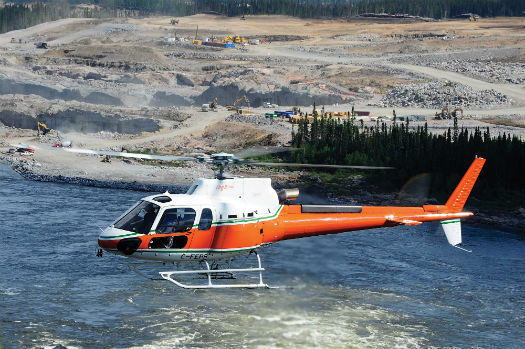
An Airbus Helicopters AS350, operated by Universal Helicopters holds a hover near Muskrat Falls in Labrador. The operator hopes the Muskrat Falls project will provide a steady amount of work, but how much of the construction activity will require helicopters remains unclear. Mike Reyno Photo
Mustang generally uses its intermediates and Bell mediums for electric utility work. On the ILM project, it used a Bell 214 for foundation construction and during the construction of the towers themselves.
“The precision of the work was the most critical challenge,” said Boyle. “All of the loads that we were delivering were in close proximity to ground crew or with crew that were secured to the tower up in the lattice structure. So the precision of the delivery is the main complexity of these types of jobs.”
The diverse range of aircraft types used on the ILM project was completed by the Kaman K-MAX, which was provided by Edmonton, Alta.-based HeliQwest.

Blackcomb Aviation is one of only a handful of companies that long lines linemen onto energized wire, for which it uses an Airbus Helicopters EC135 T2+. Marc Witolla Photo
Bob Chalifoux, president and G.M. at HeliQwest, said the K-MAX, which can lift 6,000 pounds (2,720 kilograms), is a popular aircraft among ground crews on construction projects.
“Because the rotors are offset, the downwash goes off at about a 30-degree angle to the side of the helicopter,” he said. “The ground crews love the aircraft, because they’re not getting blown all over the place.”
The operator flew up to six aircraft on the first year of the ILM project, including its Bell 206 JetRangers and Bell 205s, and was involved in operations throughout the construction process, from logging to setting towers.
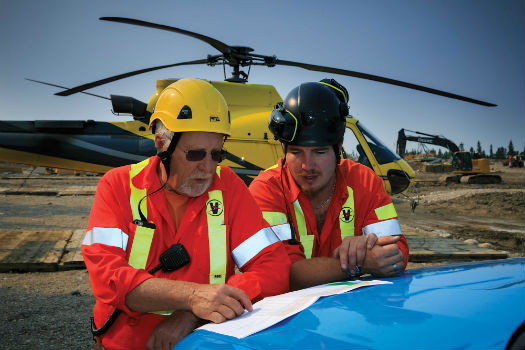
Bill Ross (left), helicopter operations manager for Valard Construction, discusses operations with pilot Matt Boekel.
“It was a good job,” said Chalifoux. “I wish I had more of those jobs, but there’s not many of them out there. There’s a few of them, which is good, but you’ve got to be specialized to do that kind of work — it’s not for everybody. All of our pilots have to have ‘fly the wire’ courses and they have to be skilled. A job where you don’t have skilled pilots won’t last very long because the power company will replace the contractor immediately, if there is an incident.”
The Longest Line
The next major infrastructure project in Canada is the Muskrat Falls project — which includes a 1,100-kilometer (680-mile) high voltage direct current transmission line between Muskrat Falls in Labrador and Soldiers Pond in Newfoundland. The overall cost of the project is estimated to be about $7 billion, with the transmission line representing about $2.7 billion of that. Work began in December 2012, and is expected to take about five years to complete.
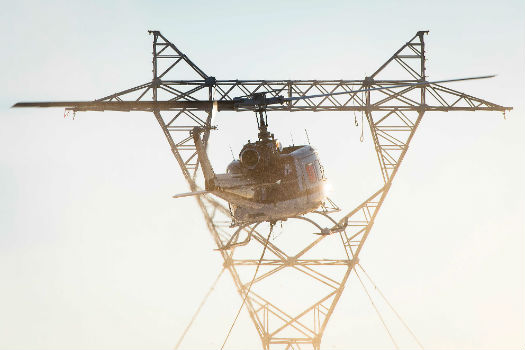
The last few years have been good for operators involved in power line construction. How much longer the current boom will continue remains to be seen. Shawn Evans Photo
Valard won the contract for constructing the transmission line from utility company Nalcor, but Ross said that he didn’t expect the project to be as flying intensive as the I1K in Saskatchewan. This sentiment was echoed by Geoff Goodyear, president of Universal Helicopters Newfoundland and Labrador LP (UHNL) — a Goose Bay, N.L.-based operator which has been subcontracted by Nalcor to provide additional support for the construction project.
“Obviously it’s in our backyard and traditionally there’s been a lot of helicopter activity on the line,” said Goodyear. “We’re doing everything we can to position ourselves to participate. Having said that, the activity levels for helicopters to date have been minimal, and certainly below what we’ve seen on other projects in the area.”
Universal’s involvement to date has involved using its AS350 B2s to move personnel and bridging material ahead of the construction process on the right of way.
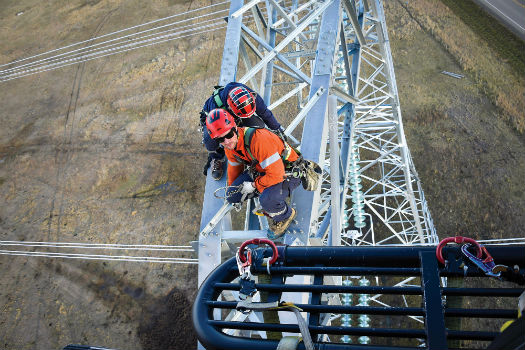
Developing trust between pilots and linemen is a hugely important part of power line operations. Shawn Evans Photo
“A lot of the power line construction here is being done by a road that they’re constructing along the right of way,” said Goodyear. “But conditions here in Labrador can vary with the seasons, and are sometimes not conducive to moving machinery over the roads. I suspect our involvement will be aligned with and affected by seasonal conditions.”
On the other side of the country, Lakelse Air’s Barry Holmes said the creation of the NTL could open the door to a great deal of potential work in northwestern B.C.’s “Golden Triangle” — a huge mineral-rich zone that contains several untapped world class deposits. Lakelse, based at the southern end of the NTL in Terrace, was involved in clearing the right of way and tower construction for that project (using AS350 B2s, a Bell 204B, and Bell 212) — work that required highly experienced mountain pilots with expert long lining skills.
Holmes said development of the Golden Triangle would require billions of dollars in construction investment, including the creation of access lines from the prospective mines to the NTL.
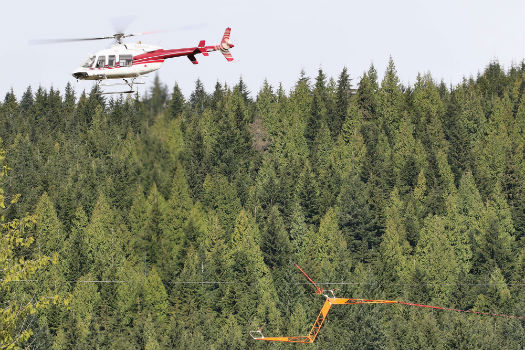
Pulling sock line is highly skilled work, and many of those with the ability are baby boomers who are retiring from the profession. “Pulling sock line and pulling needle, it is a process, but, for the most part, it’s just really good long line skills,” said Blackcomb Aviation’s Andrew Bradley. Jeff Wilson Photo
“Some lines will pass over the mountains and one power line will pass through a proposed 25-kilometer tunnel that will be built under high peaks and massive ice-fields,” he said. “These power line extensions have to be built to withstand gale and hurricane force winds coming off of the Pacific coast that can blow through these valleys, and the massive winter snow-loads that have destroyed many under-engineered towers. Building these future power lines will be challenging and require expert helicopter operators. . . . All we need now is stable commodity prices to attract the investors and mine builders.”
There certainly seems to be a positive outlook on the prospects for further electric utility construction work across the industry — even though the extent of the helicopter involvement in some of these projects is unknown. “We have backlog for at least five years of multibillion dollar projects,” said Valard’s LeBlanc. “The biggest thing with the power line industry is that all the infrastructure is really old. It was all built in the ’50s and ’60s — and power lines at that time typically had a 50- or 60-year lifespan. The investment is going ahead because it’s time.”






State of the art use of all these types and shape aircrafts.